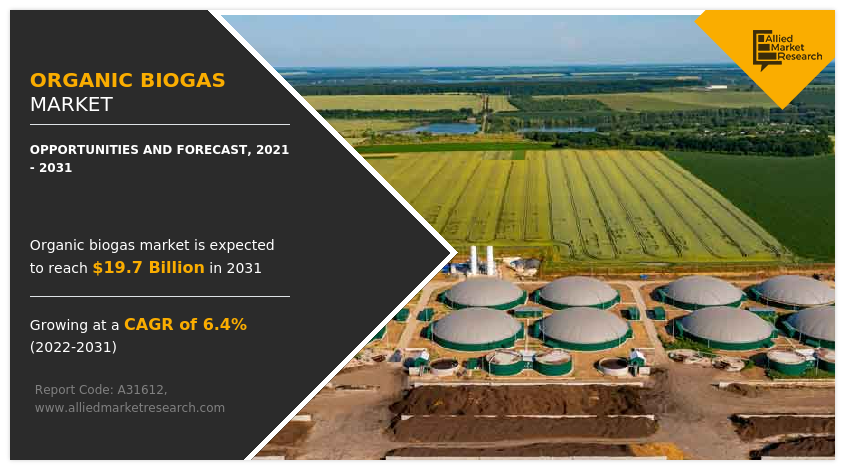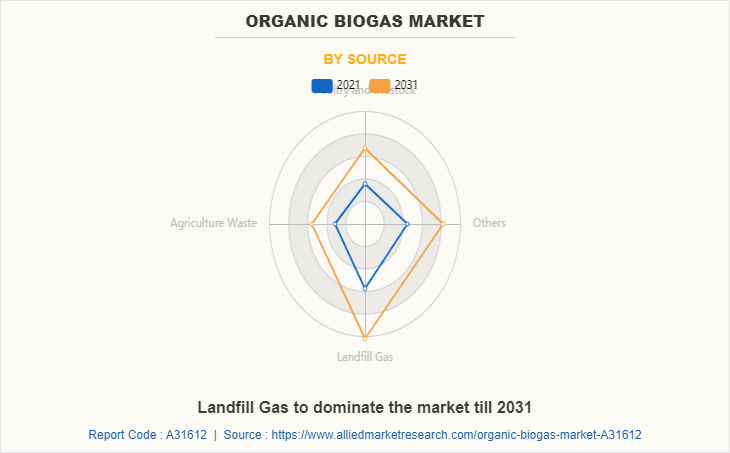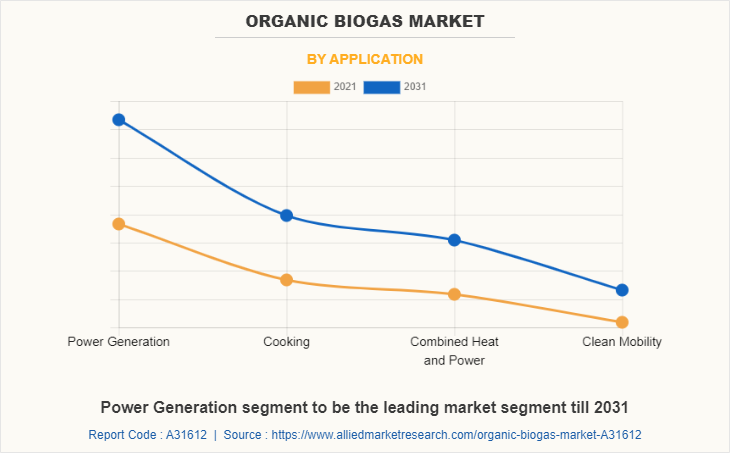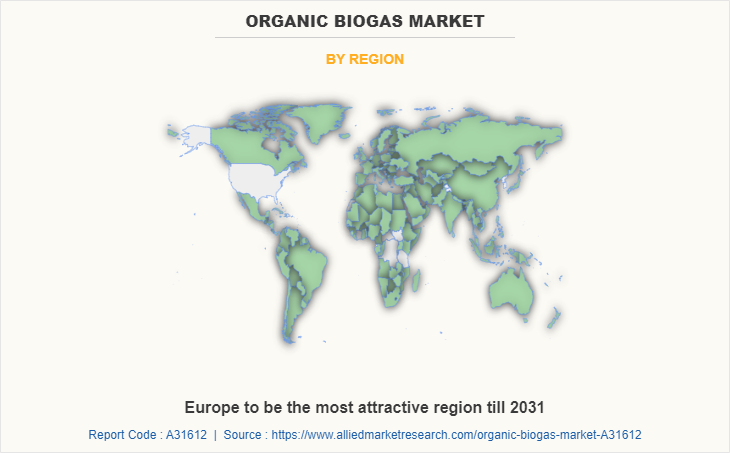Organic Biogas Market Research, 2031
The global organic biogas market size was valued at $10.7 billion in 2021, and organic biogas industry is projected to reach $19.7 billion by 2031, growing at a CAGR of 6.4% from 2022 to 2031.
Report Key Highlighters:
- The global organic biogas market has been analyzed in terns of value ($Million). The anlysis in the report is provided on the basis of source, application, and four major regions covering more than 15 countries.
- The global organic biogas market report includes detailed study covering underlying factors influencing the industry opportunities and trends.
- The report also provides detailed key participants analysis across the supply chain.
- The report also provides competitive landscape providing company profiles of major revenue contributers in the global organic biogas market.

Biogas is produced after organic materials such as plants and animal products are broken down by bacteria in an oxygen-free environment, a process called anaerobic digestion. Biogas systems use anaerobic digestion to recycle these organic materials, turning them into biogas, which contains both energies and valuable soil products. Anaerobic digestion occurs in nature, landfills, and some livestock manure management systems, which can be optimized, controlled, and contained using an anaerobic digester. Biogas contains around 50-70% methane, 30-40% carbon dioxide, and trace amounts of other gases. The liquid and solid digested materials called digestate are frequently used as soil amendments such as fertilizers.
Biogas generated from this process is generally captured to produce heat and electricity for use in engines, microturbines, and fuel cells. It can be upgraded to biomethane, also called renewable natural gas or RNG, and injected into natural gas pipelines or used as a vehicle fuel. The U.S. currently has 2,200 operating biogas systems across all 50 states and has the potential to add over 13,500 new systems. Stored biogas can provide a clean, renewable, and reliable source of baseload power in place of coal or natural gas. Furthermore, like natural gas, biogas can be used as a source of peak power. The use of all available biogas in developed and developing nations minimizes methane emissions into the atmosphere and reduces reliance on fossil fuels. The presence of benefits of biogas is a major factor driving the market growth.
The European Union is produces 3 billion cubic meters (bcm) of biogas and biomethane combined, which is equivalent to the total gas demand of Belgium. By 2030, Europe can produce 35bcm, representing 10% of the total EU gas demand. By 2050, combined biogas and biomethane production can reach 95 bcm, which could cover 30-40% of the total gas demand. Biomethane is a cost-efficient renewable fuel, especially in the heavy-duty transport and maritime sector. Biomethane can even reduce emissions below zero levels. Vehicles running on biomethane significantly reduce noise and air pollution compared to diesel, helping users to develop more sustainable, healthier urban areas. 78 European bio-LNG plants are already confirmed to be operational by 2024, having a combined production capacity of 10.6 TWh per year of this renewable fuel. This allows for the equivalent of 25,000 LNG trucks to be fueled with bio-LNG year-round well before 2025.
South Africa’s National Waste Management Strategy 2020 uses the circular economy concept as its central focus. The strategy calls for reducing the total volume of trash disposed through landfills by 40% within five years, 55% within ten years, and at least 70% within 15 years through reuse, recycling, recovery, and alternative waste treatment. In addition, there is a planned program linking the National Schools Nutrition Program to biogas digester projects. As such, the intention is to equip several schools with biogas digesters. The Western Cape Government’s Department of Environmental Affairs and Development Planning has set a target of 100% diversion of organic waste from landfill by 2027, with an interim target of 50% diversion by 2022, thereby providing lucrative growth opportunities for the development of the market.
Rapid industrial development and rise in consumer awareness- Key Factor Supporting High Growth in Asia-Pacific
Owing to rapid industrial development, a rise in consumer awareness regarding the use of biogas, and high investments in new projects contribute toward market growth. Moreover, favorable government policies such as nationwide zero organic waste to landfill boost the organic biogas market growth. In addition, the government introduces policies to encourage early investment in the processing of waste to produce energy, which augments the market growth. Furthermore, the presence of an increase in dependence on fossil fuel imports and an increase in policies and initiatives to reduce the import of fossil fuels will provide ample organic biogas market opportunities.
The organic biogas market forecast is segmented on the basis of source, application, and region. By source, the market is fragmented into poultry & livestock, agriculture waste, landfill gas, and others. Landfill gas segment is further classified into electricity, direct use, combined heat & power, and alternate fuels. Direct use segment is further categorized into boilers, direct thermal & leachate evaporation, and others. By application, the market is segregated into power generation, cooking, combined heat & power, and clean mobility. Region-wise, the market is studied across North America, Europe, Asia-Pacific, and LAMEA. Presently, Europe accounts for the largest organic biogas market share, followed by North America, Asia-Pacific, and LAMEA.

The landfill gas segment dominates the global organic biogas market. Landfills for municipal solid waste are a source of biogas. Biogas is produced naturally by anaerobic bacteria in municipal solid waste landfills and is called landfill gas. Landfill gas with a high methane content can be dangerous to people and the environment as methane is flammable.
Landfill gas contains many different gases. Methane and carbon dioxide make up 90 to 98% of landfill gas. The remaining 2 to 10% includes nitrogen, oxygen, ammonia, sulfides, hydrogen, and various other gases. The increase in municipal solid waste across the globe and the local government initiatives to manage the solid waste in the cities & towns are anticipated to drive the demand for organic biogas market. Furthermore, the depletion of conventional energy resources is anticipated to result in increased demand for landfill gas in industrial and commercial power generation. The rise in awareness among the people related to the environmental impact brought by landfill waste during this period has led to an increase in investment from private and government sectors toward the construction of landfill gas plants. The above-mentioned factors are expected to provide ample opportunities for the development of the market during the forecast period.

The power generation segment dominates the global organic biogas market. Biogas is turned into electricity using a combustion engine, fuel cell, or gas turbine, with the resulting electricity being used on-site or sold onto the electric grid. A cubic meter of biogas contains the equivalent of 6kWh of heat energy. The same volume of biogas converted to electrical power yields 2kWh, the rest of the energy is dispersed as heat that can be reclaimed and applied to other uses. Biogas can be produced in anaerobic digesters from plant or animal waste or collected from landfills. It is burned to generate heat or used in combustion engines to produce electricity.
The rise in mega investment in compressed biogas plants hints at a shift in the energy sector. Energy experts claim that compressed biogas could become the fuel of the future due to its virtue of being a clean and renewable source of energy, which is also indigenous. The increase in investment in the development of organic biogas plants across the globe is expected to reduce the cost of imports of natural gas. Furthermore, the increase in investment and the presence of government policies & regulations toward conventional power generation facilities are expected to drive the demand for organic biogas-based power generation facilities. The above-mentioned factors are anticipated to provide ample opportunities for the development of the market during the forecast period.

Europe segment dominated the global organic biogas market. Germany, France, and UK are the top three countries in the region that are contributing to the development of the market. The Europe organic biogas market is anticipated to witness significant growth during the forecast period. This is attributed to an increase in the installation of biogas plants due to the ongoing transition to a sustainable and circular economy as well as an increase in focus on cost-effective waste management strategies.
Furthermore, the introduction of national regulations and EU Directives toward renewable energy utilization is anticipated to act as a key driving force in the European market. Germany is still the largest global biogas producer. With decades of incentives especially for crop-based production on farms, its nearly 10,000 anaerobic digesters have been a model for development, especially in Europe. France had 1075 biogas production units. They included 214 units (i.e., 20%) using it in the form of biomethane, injected into networks; that number had nearly doubled in the space of a year. 686 anaerobic digestion (AD) plants operating in the UK, with a combined biogas capacity of 2,721 megawatts. By avoiding methane emissions from waste and producing green gas and biofertilizer, the sector currently cuts the UK’s annual GHG emissions by 1%.
This could rise to 6 % by 2030, should all organic wastes be captured and treated through AD. The UK Department for Business, Energy, and Industrial Strategy are soon expected to launch the Green Gas Support Scheme (GGSS). The above factors drive the growth of the organic biogas market in this region during this forecast period. The pandemic outbreak has had a significant impact on the bioenergy sector, as there were delays or even terminations of new investments in the sector mainly due to the uncertainty that has led to delays in decision-making on new investments. Governments of various developing and developed countries have taken steps to reduce the emphasis on fossil fuels as a source of electric energy.
Impact of Covid-19 on Global Organic Biogas Market
The outbreak of the pandemic has created an enormous awareness among the people related to safeguarding the environment. It provided an opportunity to diversify the economy away from oil and boost agriculture and support transportation that is environmentally friendly. Post-pandemic, there is a huge demand for the organic biogas market mostly due to an increase in awareness among the people regarding the importance of the environment and the presence of huge organic waste resources which can be used as raw materials to produce biogas which is used in the power generation and as a fuel for the transportation vehicles. In addition, the government policies and investment of the government toward the generation of biofuel and hydrogen to power future environment friendly vehicles are projected to provide lucrative opportunities for the development of the market.
Competitive Landscape
The major companies profiled in this report include Air Liquide, Atlas Copco, Biofrigas Sweden AB, CarboTech, DGE GmbH, DMT Environmental Technology, Dreyer & Bosse (Wolf GmbH), EnviTec, Guild Associates Inc., and Xebec Adsorption. Owing to an increase in the demand for eco-friendly fuels and the presence of abundant raw materials such as organic waste, deteriorating levels of petroleum reservoirs, increased awareness about the technical expertise related to the conversion process among the industrialists, and growth of the transportation sector in developing countries, such as India and China, drive the organic biogas market. The above-mentioned factors will have a positive impact on the demand for the organic biogas market. Additional growth strategies such as expansion of storage capacities, acquisition, partnership, and research & innovation in the optimization and improvement in the efficiency of the conversion of waste to biogas have led to attaining key developments in the global organic biogas market trends.
Key Developments
- Atlas Copco has agreed to acquire Pumpenfabrik Wangen GmbH, a German manufacturer of progressive cavity pumps used for transferring fluids mainly in the biogas and wastewater sectors. The company also manufactures twin-screw pumps used in sectors like food and beverage and cosmetics. The acquisition of the company will boost the market share and provide wide range of services to the biogas facilities.
- Air Liquide invested and will operate its first biomethane production unit in China by the end of 2022. Located in Huai’an City, in the Jiangsu Province, the unit will have a production capacity of 75 GWh per year. This project demonstrates a circular economy and low-carbon approach, in line with the Group’s Sustainable Objectives and strategic plan advance.
Key Benefits For Stakeholders
- This report provides a quantitative analysis of the market segments, current trends, estimations, and dynamics of the organic biogas market analysis from 2021 to 2031 to identify the prevailing organic biogas market opportunities.
- The market research is offered along with information related to key drivers, restraints, and opportunities.
- Porter's five forces analysis highlights the potency of buyers and suppliers to enable stakeholders make profit-oriented business decisions and strengthen their supplier-buyer network.
- In-depth analysis of the organic biogas market segmentation assists to determine the prevailing market opportunities.
- Major countries in each region are mapped according to their revenue contribution to the global market.
- Market player positioning facilitates benchmarking and provides a clear understanding of the present position of the market players.
- The report includes the analysis of the regional as well as global organic biogas market trends, key players, market segments, application areas, and market growth strategies.
Organic Biogas Market Report Highlights
| Aspects | Details |
| Market Size By 2031 | USD 19.7 billion |
| Growth Rate | CAGR of 6.4% |
| Forecast period | 2021 - 2031 |
| Report Pages | 268 |
| By Source |
|
| By Application |
|
| By Region |
|
| Key Market Players | dmt environmental technology, Xebec Adsorption Inc., Dreyer & Bosse (Wolf GmbH), Carbotech, L'Air Liquide S.A., Guild Associates Inc., DGE GmbH, Atlas Copco, EnviTec, Biofrigas Sweden AB |
Analyst Review
The global organic biogas market is expected to witness increased demand during the forecast period, due to a surge in demand for alternative fuels in developing countries and increase in the demand for greener alternative fuels in developed countries such as the U.S, the UK, and others. The increase in the regulations toward fossil fuels and the cost of crude oil has a massive impact on the pricing of petroleum products. Furthermore, the increase in awareness among the people toward the environment has led the major manufacturer to invest in the development of alternatives, which led to increasing demand for organic biogas.
The rise in global warming across the globe has led to a significant shift away from fossil fuels to renewable resources, which has a positive impact on the development of the organic biogas market. The rising popularity of biogas energy as a green fuel, to prevent nitrogen pollution and generate electricity, are expected to further promote industry expansion during the forecast period. Furthermore, organic gas helps in mitigating methane emissions from manure lagoons or landfills, which is later used as a fuel to reduce the climate impacts.
The organic biogas market is analyzed across North America, Europe, Asia-Pacific, and LAMEA. Among the analyzed regions, Asia-Pacific is likely to account for the highest revenue in the market throughout the forecast period, followed by North America, Europe, and LAMEA. Asia-Pacific region hosts some of the fastest developing countries such as China and India. The presence of a huge population and rapid industrialization in these countries has increased the demand for transportation fuels such as bio-CNG, and bio-LNG. The presence of demand for transportation fuels in this region and the low presence of petroleum resources in this region have led to the presence of significant importance of anaerobic digestion technology.
Initiatives toward research & development in reducing toxic emissions and government initiatives to use bio-based transportation fuel are the key factors boosting the Organic biogas market growth.
Power generation application is projected to increase the demand for Organic biogas Market
The organic biogas market forecast is segmented on the basis of source, application, and region. By source, the market is fragmented into poultry & livestock, agriculture waste, landfill gas, and others. Landfill gas segment is further classified into electricity, direct use, combined heat & power, and alternate fuels. Direct use segment is further categorized into boilers, direct thermal & leachate evaporation, and others. By application, the market is segregated into power generation, cooking, combined heat & power, and clean mobility. Region-wise, the market is studied across North America, Europe, Asia-Pacific, and LAMEA.
Air Liquide, Atlas Copco, Biofrigas Sweden AB, CarboTech, DGE GmbH, DMT Environmental Technology, Dreyer & Bosse (Wolf GmbH), EnviTec, Guild Associates Inc., and Xebec Adsorption
The market value of Organic biogas in 2031 is expected to be $19.7 billion
Implementation of environmental protection regulations is the Main Driver of Organic biogas Market.
The government policies and investment of the government toward the generation of biofuel and hydrogen to power future environment friendly vehicles are projected to provide lucrative opportunities for the development of the organic biogas market.
Loading Table Of Content...


